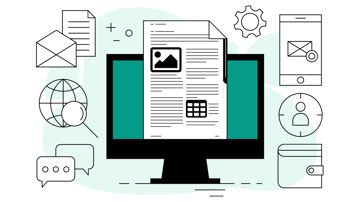In this blog we dig into tender forecasting strategies that will help you predict timelines and get a jump on your competition.
Why is Forecasting Important?
The trend is clear; the number of tenders issued each year is on the rise. To keep pace, forecasting has become a valuable tool for navigating today’s highly competitive market.
Tender planning gives you an edge by helping you:
- Stand Out from the Crowd: Craft a laser-focused pursuit and writing strategy.
- Effectively Allocate Resources: Avoid last-minute requests and expert gaps.
- Tailor Proposals: Increase proposal impact to boost evaluation scoring.
- Mitigate Risks: Carefully craft contingency plans specific to each project.
- Discover New Opportunities: Uncover new market segments and potential clients.
Challenges with Tender Forecasting
Understanding the timing of tenders, or request for proposals, is crucial for effective forecasting. However, this does involve a variety of challenges.
Client Planning
Bid timing is not random. A variety of internal and external factors influence tender timing. For example, project needs and goals as well as market conditions and regulatory requirements.
Clients typically look at their existing supplier contracts and how their current activities will change. For example, additional projects, or project completion, could trigger a need. As their activities fluctuate, existing suppliers address their needs. Or the opportunity to publish an invitation to submit for new supplier contracts presents itself.
Before moving forward with a tender, the procurement office will first make an assessment. They will compare the cost of the process versus the cost savings of procuring a new supplier contract. To achieve this, they look at a variety of influencing factors.
Industry Factors
Here are some key factors that impact tender volume and pattern:
- Emerging Technologies: Technological advancements drive demand for products or services, and could ultimately change the way tenders are conducted. For example, the rise of tendering platforms is increasing publication. But it is also shrinking deadlines, further supporting the need for careful forecasting.
- Government Policies: New legislation, projects and initiatives drive the demand for new products and services, including public-private partnerships. Think infrastructure and security development.
- Seasonal Patterns: Certain industries, such as construction, increase projects in the spring, and decrease in the fall.
- Economic Cycles: In times of growth, businesses look to spend, while during a downturn, they tend to postpone projects. However, governments may increase spending to stimulate the economy.
- Globalization: The increase in globalization has increased the number of cross-border tenders. This requires businesses to quickly adapt to different cultural and legal frameworks.
- Trade Agreements: Changes to trade agreements impact the flow of goods and services. This impacts opportunities and the businesses that bid and deliver.
- Green Initiatives: Increasing demand for eco-friendly products and services is increasing tender publication.
Market Forces
As clients consider issuing tenders, they closely monitor market forces to optimize their advantage. The preference is to act when prices are lower, versus when they anticipate higher pricing.
The following factors may affect an issuing agent's decision of when to publish an invitation to tender:
|
Market Forces that Lower Prices |
Market Forces that Increase Prices |
|
|
Basically, when a buyer purchases more or signs a longer-term contract, they often receive discounts or lower prices. On the other hand, when a buyer purchases less or reduces their contract, they may face penalties or higher prices.
Effective Strategies
In today's competitive landscape, forecasting is no longer a luxury. The more you know about the timing of a tender, the better you can prepare. Think, plan, and act beginning 12 - 24 months before.
Here are some effective strategies to help you anticipate upcoming opportunities.
Industry Trends and Developments
Follow industry-specific journals, magazines, newsletters, and social media. Watch for shifts in market demand and regulations. Monitor economic trends such as GDP growth, inflation, and interest rates.
Follow emerging technologies. Monitor shifts in buyer behavior and consumer spending.
Government Procurement Plans
Visit their website and follow them in the media. Monitor their plans, specifically policies and initiatives that may trigger tenders. Monitor regulations, legislation and economic trends that may influence government spending.
Look for new or evolving policies and initiatives that might have an impact on your industry. Monitor their partnerships with private companies.
Databases
Subscribe to online databases and platforms that aggregate tender information. Specify your industry, narrow the target geography, and set a minimum or maximum value. Create alerts based on your search criteria, and receive timely updates on new tenders that match your interests.
Analyze Patterns
Examine past tender releases, their frequency, and the timing of their publication. Look for patterns. Look for recurring trends or cycles that may indicate new opportunities.
Build Relationships
Maintain open dialogues. Develop a relationship with the procurement office. Look to where regular contact and relationship building is already naturally happening in your organization. For example, between your clients and support personnel.
Join relevant associations, attend their events, and network with industry professionals. Follow them on social media and look for presentations or articles discussing future plans.
Monitor Your Competitors
Monitor tenders lost and awarded to competitors. Know when awarded contracts expire and their option (to extend) periods. Monitor their websites and social media accounts for mentions of tenders or projects they might pursue.
Watch for interactions between their representatives and buyer influencers and decision-makers. Analyzing what they are pursuing, win or lose, also reveals their strengths and weaknesses.
Businesses that anticipate and prepare for submission get a competitive edge, and improve their chances of winning. By adopting forecasting strategies into your bidding process, you will be able to predict tenders with increasing certainty. And you will position your organization for continued success in today’s competitive market.
Remember, effective forecasting is an ongoing process. By monitoring and centralizing intel, you can ensure your efforts remain effective and relevant. And to make the most out of that planning, RFP response software like XaitPorter helps turn preparation into polished proposals that reach the finish line.












